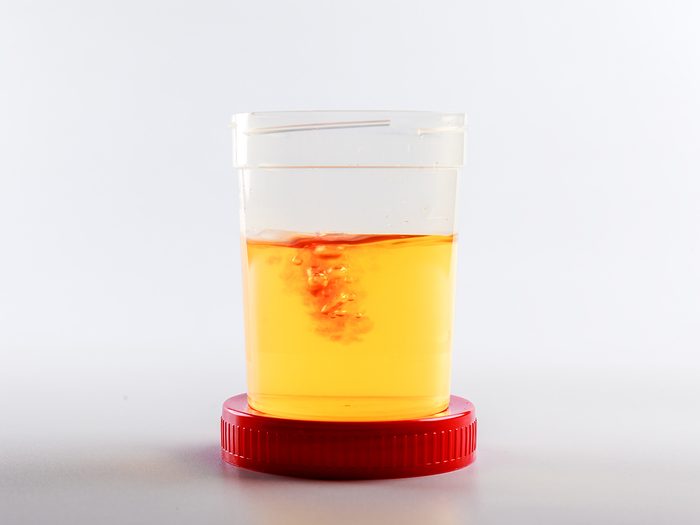6 Causes of Blood In Urine

Red pee, or what appears to be blood in urine, has many causes. Here's how to tell if it's harmless or a sign of a more serious issue.
Why is my pee red?
There’s no doubt about it: Seeing red in your urine can be scary. This likely needs to be checked out by a doctor, but red or pinkish urine in and of itself is not a reason to panic. There are many explanations for why you may see red in your urine, and many are totally benign and or easily treatable. Plus, not all red pee is the result of blood in urine.
“Urine can have a range of colours, from clear yellow to dark red,” says Tolulope Bakare, MD, an assistant professor in the department of urology at UT Southwestern Medical Center in Dallas.
The colour of your urine can change for many reasons, including the food you eat, the medicines you take, how much water you consume, how hard you hit the gym, and/or any underlying medical conditions.
Here’s what you need to know about blood in urine, red pee, and more.
Why is urine yellow, anyway?
Urine is mostly water, but it also contains salts such as sodium, potassium, and chloride. Other components include uric acid, a natural waste product from food digestion, and urea, a waste product made of ammonia and carbon dioxide. The yellow colour comes from urobilin, another waste product stemming from the breakdown of red blood cells.
Water and these substances form urine. Urine flows from the kidneys to the bladder and is carried out of your bladder through your urethra. Adults eliminate about a quart and a half of urine each day, according to the Kidney & Urology Foundation of America.

Causes of red urine
Visible blood in your urine is known as gross hematuria. Still, red urine doesn’t always mean blood, says Elizabeth Kavaler, MD, a urologist at Lenox Hill Hospital in New York City.
Here’s what could cause red pee or blood in urine.
Food or medications
Your urine may be red because of something you ate, Dr. Kavaler says. Common culprits include beets, blackberries, and rhubarb. While cranberry juice is often a recommendation to help prevent or treat urinary tract infections, it can’t turn your urine red. Think back on what you ate over the past day or two, and if any of these foods are on the list, you’ve likely got your answer.
Certain medications may also cause urine to appear red. This list includes phenazopyridine (Pyridium), a drug that numbs pain in your urinary tract and/or laxatives containing senna, Dr. Kavaler notes. (Discover the 17 everyday medication mistakes that could make you sick.)
Urinary tract infection
Urinary tract infections (UTIs) are one of the more common reasons for seeing blood in your urine, Dr. Kavaler says. It usually travels with other symptoms, including:
- Burning while urinating
- Frequent urination
- An overwhelming desire to urinate
- Pressure in your lower abdomen
Green urine could also be a sign of a bacterial infection in your urinary tract, she says. Your doctor can order a urinalysis to see if bacteria are present in your pee. UTIs are typically treated with a course of antibiotics, she says.
Kidney disease
Some kidney problems or diseases can cause urine to appear reddish or brown, Dr. Bakare says. For example, bleeding can occur when you are passing a kidney stone. Kidney stones are small pebbles of salts and minerals found in your urine, and passing them naturally can be extremely painful. There are several types of stones. If possible, save the stone so your doctor can have it analyzed as this information can better guide prevention advice.
Glomerulonephritis is the umbrella term for a group of diseases that cause inflammation in the part of the kidney that filters blood and can sometimes cause blood in urine, Dr. Bakare says. Treatment may include medication or temporary dialysis to help your kidneys function.
Polycystic kidney disease is a genetic disorder marked by cysts in the kidneys that can cause blood in your urine. There is no cure for this condition, and treatment is focused on slowing the growth of these cysts and curbing related symptoms, according to the National Kidney Foundation. (Learn the 10 silent signs of kidney cancer you might be ignoring.)
Prostate problems
In men, the prostate gland can also be a source of bleeding in urine. The prostate is a walnut-shaped gland located just below the bladder in men. An enlarged prostate from benign prostatic hyperplasia (BPH) or prostate cancer may press on the urethra, causing bladder irritation and bleeding, Dr. Kavaler says. There is also prostatitis, or inflammation of the prostate, which could be due to an infection or another cause and result in blood in the urine.
Sometimes, you can see clots or clumps of red blood in your urine, explains Marisa Clifton, MD, assistant professor of urology and the director of women’s health at the Brady Urological Institute at Johns Hopkins Medicine in Baltimore, Maryland.
“When there is enough bleeding in the urinary tract, the blood can collect and clot,” she says. This can occur from urethra bleeding, prostate bleeding, or any other source of bleeding in your urinary tract. If your doctor suspects a prostate issue, they can order more testing.
Treatment for prostate cancer is based on the stage and size of your tumor. BPH, which occurs in nearly all men as they age, is treated with medication to relax your bladder or shrink the prostate and/or surgery.
Bladder cancer
While blood in urine can be a sign of bladder cancer, this type of cancer is relatively rare. It typically affects older people (the average age at diagnosis is 73), and is more common in men than women.
About 65,000 men and 20,000 women are diagnosed with bladder cancer each year, according to the American Cancer Society. The number one risk factor for bladder cancer is smoking, Dr. Bakare says. “If there is blood in the urine, we want to rule out bladder cancer, especially if someone has a history of smoking.”
Other signs may include painful and/or frequent urination. A thorough physical exam, urine analysis, and or imaging tests can help your doctor diagnose bladder cancer. Bladder cancer treatment depends on the size and stage of the tumor, but usually involves surgery and other treatments such as chemotherapy or radiation, according to the American Cancer Society. (These are the 10 clear signs you could have overactive bladder.)
Is blood in urine coming from someplace else?
The blood could also be coming from someplace other than your urinary tract, she says. “For women, when you see red in urine, it could also be from your period or a part of your reproductive system,” Dr. Bakare explains.
How can you tell? Check to see if you are spotting at other times, she says. If you are, this may be why you see red in your urine. “Get checked out by a gynecologist,” says Dr. Bakare.
Blood that you can’t see
Sometimes there is blood in your urine that you can’t see. This is called microscopic hematuria because it is only visible under a microscope. “Guidelines state that any more than three red blood cells in a urine sample under microscope should prompt a referral to a urologist,” Dr. Bakare says. Routine urine tests can be part of annual wellness exams.
The last word
There are many potential reasons that you see blood in your urine or notice that it is red in colour. “In general, symptoms are more important than colour,” Kavaler says. “Call your doctor if you see a change in your urine that doesn’t seem linked to a new medicine you’re taking or a recent meal, especially if it lasts, worsens, or travels with symptoms.”
Along with a thorough physical exam, your doctor can order a urinalysis and possibly some blood work to help get to the bottom of it.
Next, check out why asparagus makes your pee smell.






